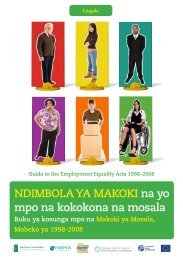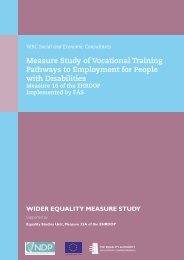Equality and Diversity - Building a Culture of ... - Equality Authority
Equality and Diversity - Building a Culture of ... - Equality Authority
Equality and Diversity - Building a Culture of ... - Equality Authority
You also want an ePaper? Increase the reach of your titles
YUMPU automatically turns print PDFs into web optimized ePapers that Google loves.
Lessons 9<br />
We are More than a<br />
Single Story<br />
Learning Intentions<br />
Students will:<br />
Explore the concept <strong>of</strong><br />
the ‘single story’ we hold<br />
about others<br />
Look at the effects single<br />
stories or stereotypes have<br />
Resources<br />
<br />
The video clips from<br />
Chimanm<strong>and</strong>a Adichie's talk.<br />
This is can be downloaded<br />
from http://www.ted.com/<br />
speakers/chimam<strong>and</strong>a_ngozi_<br />
adichie.html<br />
Copies <strong>of</strong> the transcript on<br />
page 40.<br />
“Show a people as<br />
one thing — as only<br />
one thing — over <strong>and</strong><br />
over again, <strong>and</strong> that<br />
is what they become.”<br />
Chimam<strong>and</strong>a Ngozi Adichie<br />
Homework: Ask<br />
them to complete<br />
the worksheet<br />
on Perceptions,<br />
Stereotypes <strong>and</strong><br />
Prejudice on page 41.<br />
This lesson is based on the concept <strong>of</strong> stereotypes as the<br />
‘single story’ that people hold about others, as described by<br />
Chimam<strong>and</strong>a Ngozi Adichie, author <strong>of</strong> the best selling novels,<br />
Purple Hibiscus <strong>and</strong> Half <strong>of</strong> a Yellow Sun.<br />
Activity<br />
Introduce the Chimam<strong>and</strong>a Ngozi Adichie <strong>and</strong> the concept<br />
she uses <strong>of</strong> the single story. Tell the students that you are<br />
going to show two clips from the video <strong>and</strong> that each time<br />
you stop it, they will have an opportunity to write down their<br />
immediate reactions to the clip.<br />
Clips<br />
Clip 1 The single story <strong>of</strong> Fide as ‘poor’<br />
– from 2.58 to 4.12 minutes on the video<br />
Clip 2 The single story <strong>of</strong> Chimam<strong>and</strong>a as a poor African<br />
– from 4.13 to 5.20 minutes on the video<br />
When they have heard <strong>and</strong> recorded their reactions to both<br />
clips, divide them into six groups. Give three <strong>of</strong> the groups the<br />
transcript <strong>of</strong> Clip 1 on Fide, <strong>and</strong> the other three the transcript<br />
<strong>of</strong> Clip 2 on Chimam<strong>and</strong>a. Tell them their task is now to devise<br />
a way <strong>of</strong> representing the effects <strong>of</strong> the single story on both<br />
Fide <strong>and</strong> Chimam<strong>and</strong>a <strong>and</strong> also on the people holding the<br />
single story about them, through drama or art. The idea is that<br />
they will use a representation that communicates the feelings<br />
<strong>of</strong> the people involved <strong>and</strong> do so without using words.<br />
Examples <strong>of</strong> how they might do this include:<br />
Create a drawing, illustration or symbol<br />
Create a Freeze Frame<br />
Create a mime to retell the story<br />
Give them about 10 minutes to create their representation<br />
<strong>and</strong> then ask them to demonstrate it to the rest <strong>of</strong> the class.<br />
Conclude the lesson with a class discussion on the effects <strong>of</strong><br />
the single story <strong>and</strong> the reasons why people continue to hold<br />
a single story about others.<br />
SECTION 2 EXPLORING PERCEPTIONS & STEREOTYPING 39
















